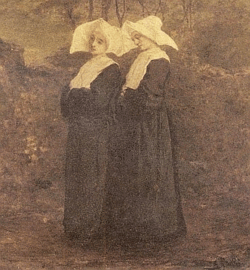Use by the Daughters of Charity
The cornette was retained as a distinctive piece of clothing into modern times by the Daughters of Charity, a society of apostolic life founded by St. Vincent de Paul in the mid-17th century. [2] The founder wanted to have a community of women that tended to the sick and poor, and were not required to remain in the papal enclosure as nuns do, resemble ordinary middle-class women as much as possible in their clothing, including the wearing of the cornette.
After the cornette generally fell into disuse, it became a distinctive feature of the Daughters of Charity, making theirs one of the most widely recognized religious habits. Because of the cornette, they were known in Ireland as the "butterfly nuns". In the United States, the Daughters of Charity wore wide, white cornettes for 114 years, from 1850 to 1964. With the changes following the apostolic constitution Perfectae Caritatis on the adaptation and renewal of religious life of the Second Vatican Council, religious congregations were asked to "return to the sources of the whole of the Christian life and to the primitive inspiration of the institutes, and their adaptation to the changed conditions of our time". [3] This, among others, meant that the Daughters of Charity ceased to wear their cornettes. [4]
This page is based on this
Wikipedia article Text is available under the
CC BY-SA 4.0 license; additional terms may apply.
Images, videos and audio are available under their respective licenses.



